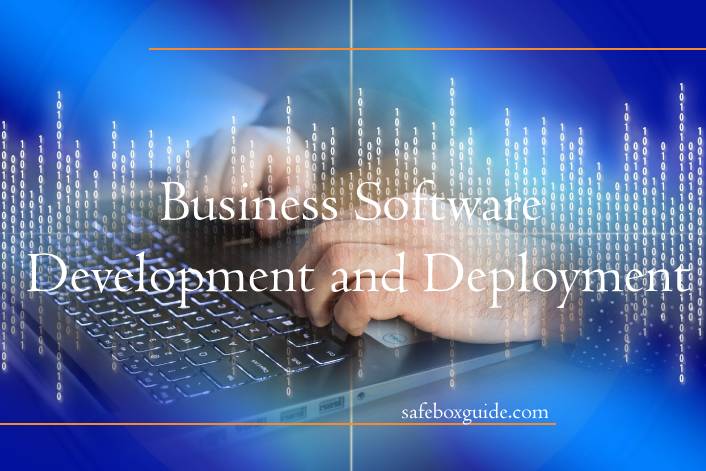In today’s technologically advanced world, businesses need to leverage the latest technology and transform their core business functions over a digital platform to survive the sheer competition. Successful deployment of information systems and business software modules helps streamline processes, implement long-term strategies, and achieve perpetual growth.
The most important aspect of business software deployment is how effectively a company can transform traditional business processes into automated workflows. It also entails how efficiently and effortlessly employees can utilize technology tools to carry out routine tasks.
When deciding to implement new software, it is critical to carefully plan and develop result-oriented strategies, analyze your needs, and communicate them effectively to software architects. Seamless software deployment is key to a business’s performance. Here are nine easy tips to help your business implement software successfully:
Contents
1. Build a competitive team

Business software is considered successful if it meets all functional and security requirements and is simple to use, maintain, and upgrade. Developing and deploying business software is a major endeavor for any business, and you want to give it your all.
Instead of risking the entire development and deployment process at the hands of amateurs, you need to build a competitive team that consists of project managers, business analysts, SQA experts, software engineers, and cybersecurity specialists. Project managers and business analysts have years of experience working with software projects, while software engineers and cybersecurity specialists are the architects that build software to perfection.
Like software engineers, cybersecurity specialists have an in-depth understanding of software development, installation, and maintenance. In addition, cybersecurity specialists are a pro at securing application data, back-end code, and databases. These essential skills are developed through higher academic endeavors pursued via online resources. Nowadays, educational institutes offer the cybersecurity management master’s program to equip IT professionals and aspiring cybersecurity experts with the latest tools and techniques aimed at securing information from cybersecurity threats and data breaches.
No matter how efficient and intelligent your business software is, it is always vulnerable to misuse and hacking by cybercriminals. Cybersecurity specialists can mitigate various cybersecurity challenges through efficient prevention and control techniques, incident response, and intrusion detection tools.
2. Identify gaps and analyze your needs
The success of your software depends on how well it resonates with your business strategy. For this reason, the team responsible for developing and deploying business software should work closely with managers, decision-makers, and prospective users of each software module.
List all your needs and communicate what you’re looking for in the software to the concerned team. If you’re outsourcing development and maintenance, you need to clearly define your expectations from the software and specify all areas of operations that need to be automated.
3. Choose between in-house or outsourced development

There’s an ongoing debate on which one between in-house development and outsourcing is best for businesses. If you want to outsource development, you need to consider between fiverr vs upwork vs freelancer. Both have their benefits and disadvantages. In-house development allows businesses to collaborate closely with the development team and provide prompt feedback on prospective software features. It also helps in continuous management and rapid upgradation of business software.
However, choosing in-house development necessitates significant investment in setting up IT departments and hiring skilled workers. In comparison, outsourcing software development helps businesses bypass these expenses and work closely with IT professionals in their field. Software companies are responsible for deploying, maintaining, and upgrading outsourced business software locally or in public, private, or hybrid clouds.
Some disadvantages of outsourced software development are that the overall service may fall below expectations, and it’s difficult to incorporate changes into the existing software.
The decision between in-house development and outsourcing is entirely up to the managers and decision-makers. Consider the advantages and disadvantages of both options and select the best option that has a long-term impact on overall business performance.
4. Test software prototype
Testing software prototype is one of the most effective strategies for developing and deploying business software. Before implementing a fully-functional version, the software development team builds and implements a prototype that works on dummy data.
The purpose of creating a prototype is to test whether the designed features of the prospective software meet business requirements. After the prototype is approved by decision-makers and software users, the software development teams start adding functionality to the business software.
5. Increase collaboration among teams

While working in teams, communication is the key to creating a collaborative environment where team members can share their ideas and develop solutions for various software aspects.
If you’re outsourcing software development, it’s important to stay in close communication with the development team and provide feedback at each stage of development.
6. Adopt a step-by-step approach
For successful software deployment, you need to take various factors into account. Most importantly, it’s crucial to adopt a step-by-step approach toward implementation. First of all, ensure the software is capable of being fully integrated into your existing information system. It must be capable of merging well with existing databases and software solutions. Changes in the new software must reflect the entire information infrastructure across the organization.
When planning the implementation, consider all aspects of this process, such as business policies, software performance under certain environments, productivity in terms of software functionality, ease of use, and backward and forward compatibility. Establish user accounts and access rights before providing software access to employees. That’s because granting an employee access to data more than their requirements may result in insider threats or unintentional data leaks.
Most business software like CRM, SCM, ERP, BI, HRM, inventory management, and POS systems are deployed in modules. The goal of modular software deployment is to introduce technology in stages rather than all at once.
7. Educate employees
Employee training is one of the most critical aspects of successful software deployment. When it comes to technology, organizations often face change resistance.
Effective change management strategies entail comprehensive employee training to equip them with the right knowledge to use technology. Your in-house IT team will help educate employees on the software’s benefits, functions and features, and data security policies.
8. Release new features as needed
Software and technology are subject to change. Every software requires consistent upgradation in features, back-end technology, and application usability. However, it’s important to take necessary feedback from end-users and decision-makers before introducing a new feature.
Release new features only when there is a gap in the software, and make the feature available to all users.
9. Assign a team for technical support and training

Employee education is essential for successful software deployment, but a single training session will not suffice. Employees face numerous issues in using the software on a day-to-day basis.
A technical support and training team will assist employees in instantly resolving their concerns and troubleshooting systems. Hold regular training sessions, especially when introducing a new feature or developing a new version. Answer each employee’s questions and value their feedback on the software to improve its functionality.
Final thoughts
Creating and deploying business software is a complex process that necessitates careful planning and execution. Setting priorities and focusing on achieving business goals will assist you in developing software that meets all your business needs.
After successful implementation, businesses must regularly evaluate the software’s performance, take feedback from all users, and derive policies to ensure data and software integrity. Keep a rollback strategy in place in case a newer version faces errors. Also, ensure the software is compatible with various platforms and devices.

